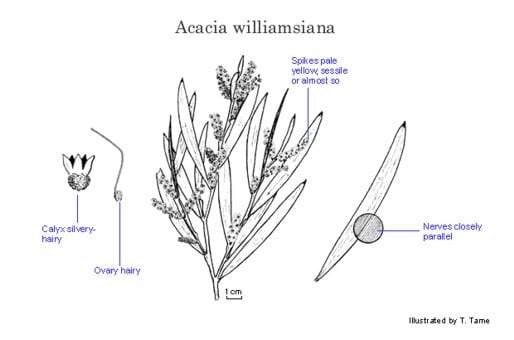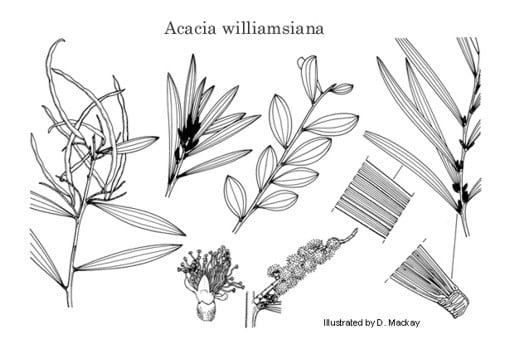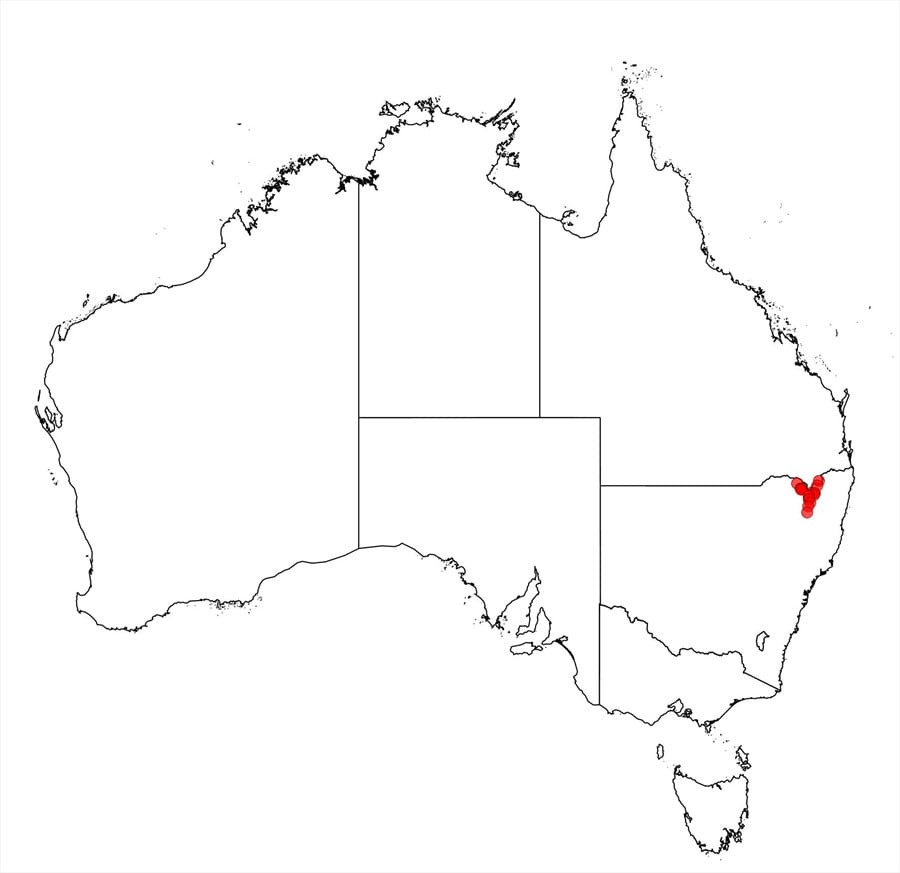Acacia williamsiana J.T.Hunter
WATTLE
Acacias of Australia
Family
Fabaceae
Distribution
Occurs as disjunct populations in north-eastern N.S.W., chiefly NW of Glen Innes to W of Ashford. Possibly also occurs in southern Qld (see note below).
Description
Tall shrub or tree 2–8 m high. Branchlets sometimes angular or flattened at extremities, glabrous, pruinose or not. Phyllodes dimorphic: on young plants widely spreading, broadly elliptic to obovate, 1.3–7.5 cm long, 13–25 mm wide; on mature plants erect, oblanceolate, elliptic to narrowly elliptic, mostly straight, acute, 4.5– 10 (–12) cm long, usually 7–13 mm wide, pale green to greyish or subglaucous, normally glabrous; longitudinal nerves numerous, fine and close together, 3–5 more prominent than the rest, anastomoses absent; minor nerves 4–8 per mm; pulvinus 0.5–3 mm long; glands absent or 1 near distal end of pulvinus. Inflorescences simple or rudimentary racemes 1–3 mm long; peduncles 0–2 mm long, coarsely longitudinally furrowed (dry), glabrous or rarely sparsely appressed-hairy at base; spikes 1.5–4 cm long, pale yellow, densely flowered; ovary hairy. Flowers 5-merous; calyx gamosepalous, very shortly dissected into triangular lobes, c. 1/3 length of corolla, lanate to tomentose especially at base. Pods linear or sub-moniliform, 3.5–9 cm long, 2–4 mm wide, ±curved, thinly textured, longitudinally wrinkled (dry), glabrous, ±pruinose. Seeds longitudinal, elliptic, dark brown to black, arillate.
Habitat
Grows in woodland and low shrubland on and around base of granite outcrops.
Specimens
N.S.W. MacIntyre Falls Fauna and Fauna Reserve, R.G.Coveny 14434 & R.O.Makinson (AD, B, BRI, BM, CANB, K, MEL, NSW, PERTH, US, Z); Severn R. Nature Reserve, NE of Glen Innes, near Pindari Dam, J.T.Hunter 3112 (NE). Qld: Ballandean, nr Stanthorpe, 10 Oct. 1966, J.Harslett s.n. (BRI).
Notes
Seemingly a member of the ‘A. cheelii group’ but its precise affinities are unclear, fide J.T.Hunter, Journal of the Royal Society of Western Australia 80(3): 235–237 (1997). Distinguished from A. cheelii by generally straighter and shorter phyllodes.
A specimen from Ballandean near Stanthorpe in southern Qld is provisionally referred to this species in some herbaria (J.Harslett s.n., 10 Oct 1966, BRI, MEL, NSW). This specimen is rather depauperate but differs from the N.S.W. occurrences of the species in having narrow phyllodes (4–6 mm wide), densely appressed-hairy peduncles and receptacles with short, spreading hairs (glabrous in N.S.W. plants). The status of this Qld entity needs to be reassessed.
FOA Reference
Data derived from Flora of Australia Volumes 11A (2001), 11B (2001) and 12 (1998), products of ABRS, ©Commonwealth of Australia
Author
B.R.Maslin
This identification key and fact sheets are available as a mobile application:
URL: https://apps.lucidcentral.org/wattle/
© Copyright 2018. All rights reserved.








